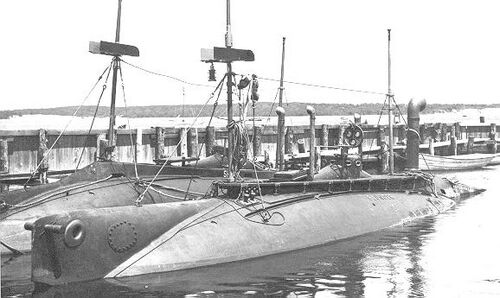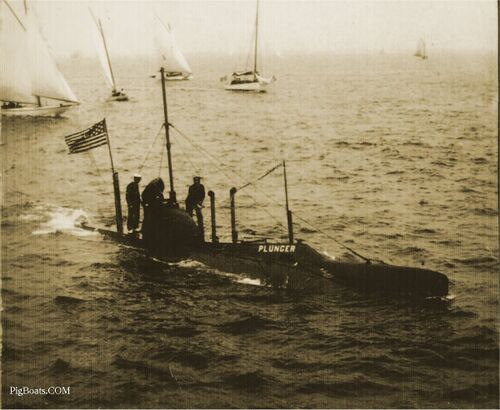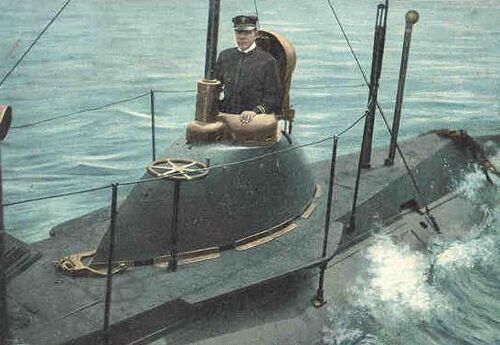A-1

Photo NH 58109 courtesy of NHHC.

Plunger being overtaken by pleasure boaters as she maneuvers, most likely on Gardners Bay, Long Island, near where the Holland company facility was located. The submarines, being so new, attracted considerable attention from the public. The photo is undated but is assumed to have been taken some time about 1903 to 1905. Probably the later date as she has a periscope mounted and she was commissioned without one.
Photo in the private collection of Ric Hedman.

This photo was taken about the same time as the one above, in Gardner's Bay, NY, approximately 1905. There are some really nice looking sailing vessels in this photo. Nearest the submarine is a gaff rigged yawl, partly concealed behind this vessel is a catboat, also gaff rigged. Seen above the power boat, probably gasoline powered, is a gaff rigged cutter.
Photo in the private collection of Ric Hedman.
President Theodore Roosevelt became the first American President to submerge in a submarine in Plunger August 25, 1905 in Oyster Bay, Long Island, NY. Plunger had been towed to New York City for this exact purpose and made the short run up to Oyster Bay just off Roosevelt's family home. On the morning of August 25, she made several short dives before she returned to her mooring alongside a tugboat. She charged her batteries in anticipation of the President's visit. Upon Roosevelt's arrival they cast off and made another series of dives with the President onboard. He spent over three hours onboard that day and left impressed with the boat and its capabilities. Being a man of action, Roosevelt immediately set into motion a chain of events that we still feel today. See below:
Should Teddy Roosevelt be the patron saint of submariners? Roosevelt was the first American President to go aboard a submarine and to make a dive. Roosevelt ventured beneath the waters of Long Island Sound aboard USS Plunger (Submarine No. 2) on August 25, 1905. Plunger was the United States' second submarine, commissioned in September 1903.
Beyond this historical first, however, is the fact that Roosevelt was the man directly responsible for submarine pay. The Naval hierarchy in 1905 considered submarine duty, neither unusual nor dangerous, and classified it as shore duty. Therefore, submariners received twenty-five percent less pay than sailors going to sea in destroyers, cruisers, and similar surface ships.
Roosevelt's two-hour trip on Plunger convinced him that this discrimination was unfair. He described submarine duty as hazardous and difficult, and he found that submariners "have to be trained to the highest possible point as well as to show iron nerve in order to be of any use in their positions"
Roosevelt directed that officer service on submarines be equated with duty on surface ships. Enlisted men qualified in submarines were to receive ten dollars per month in addition to the pay of their rating. They were also to be paid a dollar for every day in which they were submerged while underway. Enlisted men assigned to submarines but not yet qualified received an additional five dollars per month.
Roosevelt did not dilly-dally once he made a decision. He issued an Executive Order directing the extra pay for enlisted personnel. This was the beginning of submarine pay!

Plunger shown here in approximately 1907 in a colorized photo. The A-boats were rapidly modified from their as-built form, asAl operational experience showed that they had several issues. One of them was the ease at which the boat could be flooded through the conning tower hatch while running on the surface. All of the A-class received heightened conning towers and enlarged fairwaters in an attempt to rectify this problem. Plunger is shown here with those modifications. The A-class were not modified in a uniform way, with some of these topside modifications being unique. This was the case with Plunger. Also shown here is the single, non-retracting periscope mounted at the forward edge of the conning tower hatch, and a topside steering wheel on its vertical shaft.
Photo in the private collection of Ric Hedman.

Plunger was renamed A-1 on November 17, 1911 in keeping with a fleet wide renaming of submarines. She continued to serve the Navy until February 24, 1913 when she was decommissioned and her name was struck from the Naval Vessel Register. The hulk of the ex-A-1 remained for several more years. She was designated as a target for gunnery exercises but ended up being used to train salvage divers. She. a rusting hulk, was eventually hoisted aboard the old monitor ex-Puritan, seen here in this newspaper clipping at the Hitner scrap yard in Philadelphia.
The Navy had hemmed and hawed for years as to what to do with the submarine, the last of her kind on the East Coast, the rest being West Coast or on Asia Station and being consumed as targets for destroyer squadrons. During the war they had wanted to use her for aerial bombing and or explosive tests. She finally ended up laying in the mud at the end of what became known as "Rotten Row". When a large crane became available she was lifted onto the deck of the Puritan and stayed there. She and the ex-Puritan were eventually scrapped in 1922. They had been sold together as a 'single lot'.
The A-1 (Plunger) was the only A or B class submarine to be scrapped and not sunk as a target.
Photo in the private collection of Ric Hedman.
Page created by:
Ric Hedman & David Johnston
1999 - 2023 - PigBoats.COM©
Mountlake Terrace, WA, Norfolk, VA
webmaster at pigboats dot com
